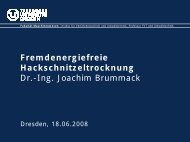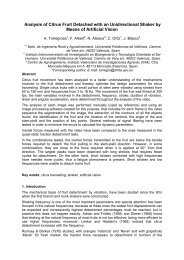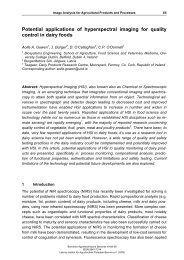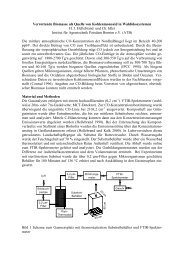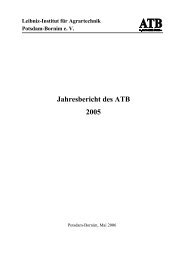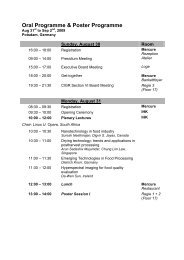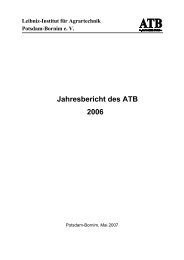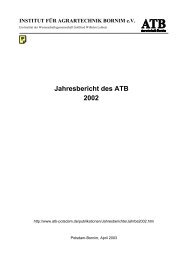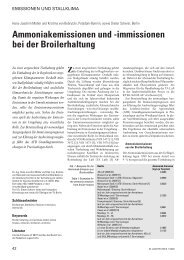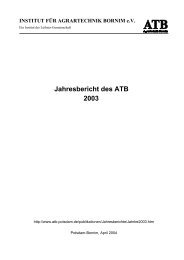Determination of Thermal Emissivity and Surface Temperature ... - ATB
Determination of Thermal Emissivity and Surface Temperature ... - ATB
Determination of Thermal Emissivity and Surface Temperature ... - ATB
You also want an ePaper? Increase the reach of your titles
YUMPU automatically turns print PDFs into web optimized ePapers that Google loves.
<strong>Determination</strong> <strong>of</strong> <strong>Thermal</strong> <strong>Emissivity</strong> <strong>and</strong> <strong>Surface</strong> <strong>Temperature</strong> Distribution <strong>of</strong><br />
Horticultural Products<br />
Hans J. Hellebr<strong>and</strong>; Horst Beuche; Manfred Linke<br />
Institute <strong>of</strong> Agricultural Engineering Bornim (<strong>ATB</strong>), Max-Eyth-Allee 100, 14469 Potsdam,<br />
Germany; Phone +49-331-5699-0; Fax +49-331-5699-849<br />
email: jhellebr<strong>and</strong>@atb-potsdam.de; hbeuche@atb-potsdam.de; mlinke@atb-potsdam.de<br />
Abstract<br />
A temperature decrease <strong>of</strong> the surface is observed, when heat is transmitted from<br />
the product for the transpiration <strong>of</strong> biological products like fruits <strong>and</strong> vegetables. By<br />
thermal imaging, this change in temperature can be measured <strong>and</strong> used for the<br />
quality evaluation <strong>of</strong> horticultural products. In the experimental studies performed<br />
here, a commercial infrared thermal imaging camera has been applied having a<br />
temperature resolution <strong>of</strong> better than 0.1 K. Since the intensity <strong>of</strong> thermal radiation is<br />
related to the temperature to the power <strong>of</strong> four <strong>and</strong> is directly proportional to the<br />
emission factor <strong>of</strong> the sample, this emission factor (emissivity) must be known.<br />
Different experiments were performed by using markers with known emissivity <strong>and</strong><br />
by contact measurements in order to determine the emissivity <strong>of</strong> different horticultural<br />
products. The results indicate that the emissivity is in the range <strong>of</strong> 0.94 ± 0.04 for all<br />
those horticultural products studied here.<br />
Introduction<br />
<strong>Thermal</strong> imaging has become an important tool in research <strong>and</strong> production in many<br />
branches in connection with dropping costs over the last decades. At present, new<br />
applications in agriculture <strong>and</strong> horticulture are visible like designing <strong>and</strong> control <strong>of</strong><br />
storage houses <strong>and</strong> vegetable displays, quality evaluation <strong>and</strong> control <strong>of</strong> sensitive<br />
biological products (Linke et al 2000). The imaging camera is utilised normally as a<br />
"two-dimensional" thermometer. In reality, the thermal radiant flux (or radiation flux)<br />
at a limited wavelength b<strong>and</strong> (3 - 5 µm or 7 -14 µm, dependent on type <strong>of</strong> sensor) is<br />
measured. This two-dimensional distribution <strong>of</strong> the radiant flux <strong>of</strong> a three-dimensional<br />
object is then converted into a temperature distribution. At least two main error<br />
sources limit the accuracy <strong>of</strong> the temperature determination:<br />
- The radiant flux Φ depends on the emissivity ε <strong>and</strong> on the temperature Τ (Stefan-<br />
Boltzmann law)<br />
Φ = ε Τ 4 σ Α<br />
with Α the surface area <strong>of</strong> the radiating body <strong>and</strong> σ a proportionality constant<br />
(dimension factor). Therefore, the emissivity <strong>of</strong> the object in the interesting<br />
waveb<strong>and</strong> must be known to convert radiation data into temperature. Usually a
2<br />
"global" emissivity is taken (e g ε = 1 assuming blackbody radiation or ε = 0.95 for<br />
outdoor images). The results are called apparent temperatures. For accurate<br />
measurements, the emissivity <strong>of</strong> the object must be known.<br />
- The thermal radiation <strong>of</strong> a body is a superposition <strong>of</strong> direct (specular) radiation with<br />
an intensity distribution according Lambert's (cosine) law <strong>of</strong> illumination <strong>and</strong> <strong>of</strong> diffuse<br />
radiation. Diffuse radiation is typical for high temperature ( > 1000 K). The share <strong>of</strong><br />
direct radiation <strong>of</strong> water, the main component <strong>of</strong> fruits <strong>and</strong> vegetables, depends on<br />
the thickness <strong>of</strong> the water layer (Haußecker 1996). Only those areas <strong>of</strong> fruits will be<br />
measured correctly, which are parallel oriented to the sensor plane <strong>of</strong> the camera.<br />
This effect is visible in thermal images <strong>of</strong> spherical shaped fruits e.g. apples or<br />
tomatoes. The temperature at the outer circumference seems to be lower than from<br />
the centre <strong>of</strong> the fruit.<br />
In this paper, the aim is to report <strong>and</strong> to discuss measurements <strong>of</strong> the emissivity <strong>of</strong><br />
fruits. Until now, only few data on the emissivity <strong>of</strong> fruits <strong>and</strong> vegetables are given in<br />
the literature. In st<strong>and</strong>ard h<strong>and</strong>books, the emissivity <strong>of</strong> water, wood, paper <strong>and</strong> some<br />
other organic materials is listed. The emissivities <strong>of</strong> these materials are in the range<br />
between 0.80 <strong>and</strong> 0.95 (e g King 1987, Ebert 1962).<br />
Materials <strong>and</strong> methods<br />
An IR imaging camera "Varioscan 3021-ST" serves for the measurement <strong>of</strong> the<br />
radiant flux. The s<strong>of</strong>tware "IRBIS Plus V2.0" enables inputs <strong>of</strong> emissivity as "global"<br />
for the whole image, <strong>and</strong> as "local" for a definite area or a free definable pixel range.<br />
The measuring principle is to use a calibrated marker at the surface <strong>of</strong> the fruit to get<br />
the true surface temperature (Fig. 1). Marker <strong>of</strong> different materials are measured at<br />
the surface <strong>of</strong> a temperature controlled aluminium ingot containing a blackbody<br />
radiator (black hole C01 in Fig. 2).<br />
IR <strong>Thermal</strong><br />
imaging camera<br />
Varioscan3021-ST<br />
with s<strong>of</strong>tware<br />
IRBIS Plus<br />
Adhesive marker<br />
apple<br />
Contact foil<br />
10 µm<br />
Support<br />
Fig. 1 Scheme <strong>of</strong> the<br />
measuring principle.
3<br />
Fig. 2 <strong>Thermal</strong> image <strong>and</strong> apparent temperatures (ε = 1) <strong>of</strong> calibration<br />
measurements (C01: blackbody radiator; C02: white paper; C03: adhesive paper;<br />
C04: adhesive aluminium foil; C05: aluminium ingot).<br />
The temperature <strong>of</strong> the aluminium ingot is regulated by an intern water bath. The<br />
emissivity <strong>of</strong> the blackbody radiator is measured by dynamic temperature<br />
measurements (heating curves <strong>and</strong> cooling curves), as it is necessary to have<br />
temperature contrasts. In thermal equilibrium at room temperature, no image will be<br />
get. The measurement error increases at low contrast (near room temperature)<br />
because <strong>of</strong> small signal to noise ratio. The ingot temperature is measured with<br />
thermocouples <strong>and</strong> the radiant flux with the imaging camera. The emissivity <strong>of</strong> the<br />
blackbody radiator is found such a way as 0.99. With this value, the emissivity <strong>of</strong> the<br />
markers is get (Fig. 3).<br />
<strong>Emissivity</strong> ; rel. units<br />
1.5<br />
1.2<br />
0.9<br />
0.6<br />
ideal black body ε = 1; (C01: ε = 0.99)<br />
white paper (C02) :<br />
adhesive white paper (C03) :<br />
adhesive aluminium foil (C04)<br />
0.3<br />
aluminium ingot (C05)<br />
0.0<br />
18 24 30 36<br />
<strong>Temperature</strong> T; °C<br />
Fig. 3 <strong>Emissivity</strong> <strong>of</strong> different materials (ambient temperature 22.5 °C).<br />
As marker for the fruit experiments, small pieces <strong>of</strong> adhesive paper are taken, since<br />
they show nearly no variation in emissivity (ε = 0.924), <strong>and</strong> this type <strong>of</strong> marker can
4<br />
easily be h<strong>and</strong>led. Since a marker seals locally the surface <strong>and</strong> stops such a way the<br />
transpiration with local changes in the temperature, the solution is a protecting foil<br />
(10 µm polyethylene), which covers other parts <strong>of</strong> the fruit too <strong>and</strong> guaranties similar<br />
ambient conditions during the time <strong>of</strong> measurement. Therefore, the transmission<br />
properties <strong>of</strong> foils had to be measured. Measurements <strong>of</strong> the calibration device<br />
without foil <strong>and</strong> with two different foils (10 µm <strong>and</strong> 30 µm) do not change the<br />
calibration, hence it is possible to use transparent foils as cover in emissivity<br />
measurements <strong>of</strong> fruits.<br />
Results <strong>and</strong> discussion<br />
To determine the emissivity, it is necessary to know the radiant flux (radiation<br />
intensity) <strong>and</strong> the true temperature <strong>of</strong> the radiating surface. Assuming a similar<br />
temperature near the marker C01, the known temperature <strong>of</strong> the calibrated marker is<br />
set as the temperature <strong>of</strong> the measuring circles C02 <strong>and</strong> C03 at the fruit (Fig. 4).<br />
Fig. 4 Part <strong>of</strong> the thermal image <strong>of</strong> an apple<br />
(Golden delicious) with adhesive paper<br />
marker (C01: ε =0.924, T=30.726 °C) <strong>and</strong><br />
measuring circles (C02, T=31.128 °C; C03,<br />
T=31.102 °C). These temperatures are<br />
mean values <strong>of</strong> pixels inside the circles. The<br />
apparent temperatures correspond to a<br />
global emissivity <strong>of</strong> the images <strong>of</strong> ε = 1<br />
(ambient temperature 22.5 °C).<br />
0,99<br />
32,0<br />
<strong>Emissivity</strong> ε; rel. units<br />
0,98<br />
0,97<br />
0,96<br />
0,95<br />
T (C01; ε = 0.924)<br />
C02<br />
C03<br />
0 50 100 150 200 250 300<br />
Time t; s<br />
Fig. 5 Time dependent<br />
measurement<br />
(temperature decay)<br />
<strong>of</strong> apple emissivity<br />
(Golden delicious;<br />
ambient temperature<br />
22.5 °C).<br />
Then the emissivity at the circles C02 <strong>and</strong> C03 is found by changing the inputs for<br />
the s<strong>of</strong>tware until the measuring circles C02 or C03 show the same temperature as<br />
the marker. The measurement <strong>of</strong> fruit emissivity has to be performed as dynamic<br />
temperature measurements in order to have sufficient contrast. Therefore, the fruits<br />
C02<br />
C03<br />
31,5<br />
31,0<br />
30,5<br />
30,0<br />
<strong>Temperature</strong> T; °C
5<br />
are warmed up for few hours (sealed in plastic foils) at 32 °C, then placed at a<br />
support <strong>and</strong> thermal images are taken every 30 s. After 120 s, the fruit with marker is<br />
pressed against the protecting foil <strong>and</strong> imaging is continued up to 270 s (Fig. 5).<br />
The decline <strong>of</strong> the apparent emissivity <strong>of</strong> C02 <strong>and</strong> C03 till 120 s results mainly from<br />
transpiration caused temperature differences between marker <strong>and</strong> measuring circles.<br />
After stopping transpiration by the protecting foil, the temperature increases <strong>and</strong> the<br />
true emissivity is measurable. There are several error sources. Changing air<br />
conditions give deviations in the radiation flux measurements. <strong>Temperature</strong> gradients<br />
between marker <strong>and</strong> measuring circles result in incorrect emissivity calculations.<br />
Thus the placing <strong>of</strong> the measuring circles is important. From Fig. 4 it can be seen that<br />
there is a local variability <strong>of</strong> temperature in the surrounding <strong>of</strong> the marker.<br />
Fig. 6 <strong>Thermal</strong><br />
image <strong>and</strong><br />
temperature<br />
pr<strong>of</strong>ile across<br />
an apple<br />
(Golden<br />
delicious;<br />
ε = 0.965) <strong>and</strong><br />
marker part C01<br />
(ε = 0.924)<br />
without<br />
protecting foil.<br />
One explanation is, this might be an insufficient tightening between foil <strong>and</strong> fruit<br />
surface resulting in thin insulating air layers or water vapour layers. Further careful<br />
experiments must be performed to analyse this situation. The first measured<br />
emissivities are in the range 0.90 to 0.97 (apple: 0.94 - 0.97; pear: 0.95 - 0.96;<br />
nectarine: 0.93 - 0.95; tomato: 0.90 - 0.95). Since these numbers are get from one to<br />
three fruits each, more measurements must be performed for statistical verification <strong>of</strong><br />
these preliminary results.
6<br />
The temperature distribution <strong>of</strong> an apple will be get by using the measured emissivity<br />
<strong>and</strong> temperature pr<strong>of</strong>iles (Fig. 6). A circle C01 is set with ε = 0.924, the emissivity <strong>of</strong><br />
the marker. The effect <strong>of</strong> direct radiation is visible, the "true temperature" is valid for<br />
the centre <strong>of</strong> the image only. The share <strong>of</strong> "Lambert's cosine law radiation" causes<br />
this apparent temperature decrease from the centre to the circumference.<br />
Additionally, at the circumference we have a superposition with the laminar boundary<br />
layer, which results from transpiration <strong>and</strong> heat exchange with ambient air.<br />
Conclusions<br />
The measuring place developed here gives the possibility to study the influence <strong>of</strong><br />
type, maturity, <strong>and</strong> other factors <strong>of</strong> fruits, which could influence the emissivity. Since<br />
emissivity measurements must be performed by dynamic temperature<br />
measurements, the change <strong>of</strong> thermal properties with temperature is to be pro<strong>of</strong>ed<br />
carefully. The first results indicate that emissivity <strong>of</strong> a definite part <strong>of</strong> the surface<br />
(pixels in measuring circle) can be determined accurately. Due to the principle<br />
applied (calibrated marker <strong>and</strong> 10 µm protecting foil), a higher variability occurs in the<br />
surface temperature <strong>of</strong> fruits near the marker. Further studies are necessary to find<br />
the sources <strong>of</strong> this variability (thin air layers or water vapour) <strong>and</strong> to find rules for<br />
correct setting <strong>of</strong> the measuring circles. The first measured emissivities are in the<br />
range 0.90 to 0.97 (apple: 0.94 - 0.97; pear: 0.95 - 0.96; nectarine: 0.93 - 0.95;<br />
tomato: 0.90 - 0.95).<br />
References<br />
Ebert H (1962) Physikalisches Taschenbuch. Vieweg&Sohn Braunschweig, pp 349-<br />
354<br />
King W J (1987) <strong>Emissivity</strong> <strong>and</strong> absorption. In R. C. Weast ed, H<strong>and</strong>book <strong>of</strong><br />
Chemistry <strong>and</strong> Physics, CRC Press, Boca Raton (Florida), pp E-393 - E-395<br />
Haußecker H (1996) Messung und Simulation von kleinskaligen Austauschvorgängen<br />
an der Ozeanoberfläche mittels Thermographie. PhD thesis. Ruprecht-Karls-Universität,<br />
Heidelberg<br />
Linke M, Beuche H, Geyer M, Hellebr<strong>and</strong> H J (2000) Possibilities <strong>and</strong> limits <strong>of</strong> the<br />
use <strong>of</strong> thermography for the examination <strong>of</strong> horticultural products. Agrartechnische<br />
Forschung 6: 110-114



